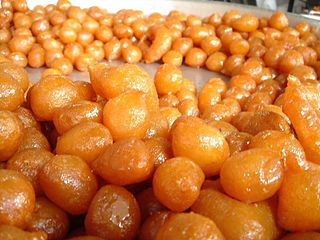| Type | Dessert |
|---|---|
| Place of origin | Cape Verde |
| Main ingredients | Eggs, molasses, water, aguardente liquor, oil |
Bolinhos de mandioca com mel ("little balls of manioc with honey") is a traditional Cape Verdean dessert.
It is made by mixing whole eggs with molasses (referred to in Portuguese as "cane honey"). To this are added water, aguardente liquor, and oil. The ball is then rolled in manioc flour to form balls which are then baked in an oven. [1]

Dessert is a course that concludes a meal. The course consists of sweet foods, such as candy, and possibly a beverage such as dessert wine and liqueur. Some cultures sweeten foods that are more commonly savory to create desserts. In some parts of the world there is no tradition of a dessert course to conclude a meal.

Cape Verde is known internationally for morna, a form of folk music usually sung in the Cape Verdean Creole, accompanied by clarinet, violin, guitar and cavaquinho. Funaná, Coladeira, Batuque and Cabo love are other musical forms.
Cape Verdean Americans are an ethnic group of Americans whose ancestors were Cape Verdean. In 2010, the American Community Survey stated that there were 95,003 Americans living in the US with Cape Verdean ancestors.

Cape Verdean Portuguese is the variety of Portuguese spoken in Cape Verde.

The Culture of Cape Verde is rich, with a range of customs and practices common in the islands.

A buñuelo (Spanish:[buˈɲwelo]; alternatively called boñuelo, bimuelo, birmuelo, bermuelo, bumuelo, burmuelo, or bonuelo is a fried dough fritter found in Spain, Latin America, and other regions with a historical connection to Spaniards, including Southwest Europe, the Balkans, Anatolia, and other parts of Asia and North Africa. Buñuelos are traditionally prepared at Christmas. It will usually have a filling or a topping. In Mexican cuisine, it is often served with a syrup made with piloncillo.

The cuisine of the Democratic Republic of the Congo and the Republic of the Congo varies widely, representing the food of indigenous people. Cassava, fufu, rice, plantain and potatoes are generally the staple foods eaten with other side dishes.

Lokma is a dessert originated from Egypt made of leavened and deep fried dough balls, soaked in syrup or honey, sometimes coated with cinnamon or other ingredients. The dish was described as early as the 13th century by al-Baghdadi as luqmat al-qādi, "judge's morsels".

A filhó is a traditional dessert in Portugal and Northeastern Brazil.
The Alfabeto Unificado para a Escrita do Caboverdiano, commonly known as ALUPEC, is the alphabet that was officially recognized by the Cape Verdean government to write Cape Verdean Creole.
The Cabo Verdean diaspora refers to both historical and present emigration from Cape Verde. Today, more Cabo Verdeans live abroad than in Cape Verde itself. The country with the largest number of Cape Verdeans living abroad is the United States.

The Cape Verdean passport is issued to citizens of Cape Verde for international travel. Cape Verdean citizens can travel to member states of the Economic Community of West African States (ECOWAS) visa-free.

Cape Verde or Cabo Verde, officially the Republic of Cabo Verde, is an archipelago and island country in the central Atlantic Ocean, consisting of ten volcanic islands with a combined land area of about 4,033 square kilometres (1,557 sq mi). These islands lie between 600 and 850 kilometres west of Cap-Vert, the westernmost point of continental Africa. The Cape Verde islands form part of the Macaronesia ecoregion, along with the Azores, the Canary Islands, Madeira, and the Savage Isles.
This page list topics related to Cape Verde.

The cuisine of Sardinia is the traditional cuisine of the island of Sardinia, and the expression of its culinary art. It is characterised by its own variety, and by the fact of having been enriched through a number of interactions with the other Mediterranean cultures while retaining its own identity. Sardinia's food culture is strictly divided into food from the land and food from the sea, reflecting the island's historical vicissitudes and especially its geographic landscapes, spacing from the coastline to the ragged mountains of the interior. The Sardinian cuisine is considered part of the Mediterranean diet, a nutritional model that was proclaimed by UNESCO as an intangible cultural heritage.
The Taça de Cabo Verde is the main knock-out football tournament of the Cape Verde islands. It started in 1982, it was later revived in 2007 and is played annually. The competition features the winners of each island or regional cup competition and competes into two groups.

Angolan cuisine has many dishes popular among nationals and foreigners, including funge, mufete, calulu, moamba de galinha, moamba de ginguba, kissaca, and mukua sorbet.

The cuisine of Cape Verde is a West African cuisine largely influenced by Portuguese, Southern and Western European and West African cuisine. Cape Verde was a colony of Portugal from its colonization until 1975.
Benne balls or sometimes spelled Bene balls are a dessert from Trinidad and Tobago, made of sesame seeds and some combination of molasses, sugar, or honey. Round in shape and covered in whole sesame seeds, benne balls have an extremely hard consistency that is compared to jawbreaker candy. Benne balls were invented by Afro-Trinidadian descendants of slaves, and the word "benne" is adopted from an African word for "sesame".